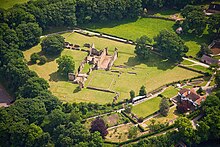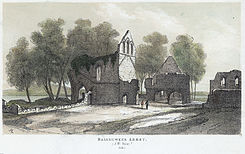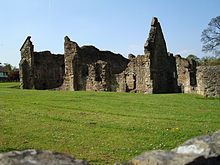Basingwerk Abbey
| Basingwerk Abbey | |
|---|---|
Abaty Dinas Basing | |
 Remains of Basingwerk Abbey | |
| Religion | |
| Affiliation | Catholicism,Cistercians |
| Ecclesiastical or organizational status | ruins |
| Year consecrated | 1132 |
| Location | |
| Location | Holywell,Flintshire,Wales |
| Architecture | |
| Type | Monastery |
| Style | Cistercian |
Basingwerk Abbey(Welsh:Abaty Dinas Basing) is aGrade I listedruinedabbeynearHolywell,Flintshire,Wales.The abbey, which was founded in the 12th century, belonged to theOrder of Cistercians.It maintained significant lands in the English county ofDerbyshire.The abbey was abandoned and its assets sold following theDissolution of the Monasteriesin 1536.
The site is now managed byCadw– the national Welsh heritage agency.
Medieval history
[edit]

The abbey was founded in 1132 byRanulf de Gernon, 4th Earl of Chester,[1]who had already broughtBenedictinemonks fromSavigny Abbeyin southernNormandy.Likely the first location of the abbey was not at the current location at Greenfields but at the nearby Hen Blas.[2]The abbey became part of theCistercianOrder in 1147, when theSavignac Ordermerged with the Cistercians. It was a daughter house ofCombermere Abbeyin Cheshire,[3]of which Earl Ranulf was a great benefactor. However, in 1147 the abbot and convent of Savigny transferred it toBuildwas AbbeyinShropshire.[4]: 52 Twenty years later, the monks of Basingwerk challenged their subjection to Buildwas, but Savigny found against them and sent a letter notifying their decision to the abbot ofCîteaux,the head of the Cistercian order.[4]: 54 AnEarl of Chestergave the manor ofWest Kirbyto the Abbey.
In 1157,Owain Gwyneddencamped his army at Basingwerk, though at the Hen Blas site not at the current site,[5]before facing the forces ofHenry IIat theBattle of Ewloe.TheWelsh Princestopped at the abbey because of its strategic importance. It blocked the route Henry II had to take to reachTwthill, Rhuddlan.In the fighting that followed, Owain Gwynedd split his army routing the English nearEwloe.
The abbey had significant lands in the English county ofDerbyshire.Henry IIgave the monks a manor nearGlossop.The Monks' Road and theAbbot's Chairnear the town are a reminder of the Abbey's efforts to administer their possession. In 1290 the Abbey gained amarket charterfor Glossop.[6]The monks also got another charter for nearbyCharlesworthin 1328.
By the 13th century, the abbey was under the patronage ofLlywelyn the Great,Prince ofGwynedd.His sonDafydd ap LlywelyngaveSt Winefride's Wellto the abbey. The monks harnessed the power of the Holywell stream to run a corn mill and to treat the wool from their sheep. The monks sided with the English inEdward I's late 13th centuryconquest of Wales,for which they were rewarded with permission to hold a market and fair at Holywell.[7]In 1433, the monks leased all ofGlossopdalein Derbyshire to the Talbot family, the futureEarls of Shrewsbury(1442). The increasing worldliness of the abbey by this time can be seen in the rebuilding of the domestic buildings to make them more comfortable, and in the abbot's patronage of bards likeTudor Aled.[8]There was also some laxity in the religious observance - the last abbot, Nicholas Pennant, was the son of his predecessor Thomas.[7]
A legend says a 12th-century Basingwerk Abbey monk was lured into a nearby wood by the singing of anightingale.He thought he had only been listening a short while, but when he returned, the abbey was in ruins. He crumbled to dust shortly afterwards.[9]
At theValor Ecclestiasticussurvey of 1535, Basingwerk was assessed at £150, putting it among the smaller houses that were earmarked for closure. By this time the number of monks had probably dwindled to two or three.[8]In 1536, abbey life came to an end with theDissolution of the Monasteriesduring the reign ofHenry VIII.Its dissolution was made lawful by theDissolution of the Lesser Monasteries Actand the lands of the abbey were granted to lay owners, with the site itself passing to Henry ap Harry ofLlanasa.The abbot received a pension of £17 per annum.
Two centuries earlier a Welsh seer,Robin Ddu( "Robin the Dark" ), said the roof on the refectory would go to a church underMoel Famau.It did: when the abbey was sold, the parts of the roof went toSt Mary's ChurchinCilcainbelow the slopes of Moel Famau. Another section of roof was reportedly given to theCollegiate and Parochial Church of St PeteratRuthin,where it still covers the North Nave. ItsJesse windowwent to the Church of St Dyfnog atLlanrhaeadr-yng-Nghinmeirch.The choir stalls went toSt Mary on the Hill, Chester,and some of the roofing lead was used to repairHolt Castle,as well as several royal castles in Ireland.[8][7]
Present day
[edit]
Since 1923, the remains of the abbey have been in state care. The ruins are part ofGreenfield Valley Heritage Park,and are managed byCadw.In common with most medieval monasteries, the abbey buildings were centred on a large church, with the domestic buildings of the monks in three ranges surrounding acloisterto its south. The majority of the buildings, including the church, were erected in the 13th century.[7]The 50m long cruciform church has been reduced to foundations and low walls except for the south transept, where the west walls still stands high with one high window and the arch that led to the south aisle.[7]Of the buildings round the cloister more remains, as they were converted to a house after the Dissolution. Immediately south of the church is thesacristy,then thechapter house.This is a 12th century room, to which a vaulted eastern section was added, divided by an arcade of two round arches which still stands. Around the walls is the bench on which the monks sat for chapter meetings. To the south is the dormitory undercroft, and to the south of that a warming room was added in the mid-13th century.[7]This end of the range was heavily rebuilt in the later middle ages, with the vault being removed and a new hall and chamber built.[10]Over this range stood the monks' dormitory, of which part of the side walls still stand, withlancet windows.Extending east from the south end of this range is another range of uncertain date, possibly incorporating the infirmary or abbot's house.[11]In the south range are the staircase up to the dormitory, and therefectory.In the normal Cistercian manner, this is aligned north-south, perpendicular to the body of the range. It was a high-quality chamber, and elaborate lancets withEarly Englishshafting survive in the west wall, along with the reader's pulpit and the hatch to the kitchen.[8]Of the kitchen, and the entire west range, virtually nothing survives. The latter was separated from the cloister proper by a 'lane', as can be better seen at the Cistercian houses ofBuildwasandByland.
The abbey marks the starting point of theNorth Wales Pilgrims Way.[12]
See also
[edit]- List of monastic houses in Wales
- List of Cadw properties
- The Form of Preaching,a 14th-century style book or manual about a preaching style
- Holywell Junction railway station
Footnotes
[edit]- ^Ivanov, Bojan (4 May 2018)."The ruins of Basingwerk Abbey, Wales: artistic and economic center for over 400 years".Abandoned Spaces.Retrieved5 February2021.
- ^Ross, David (n.d.)."Basingwerk Abbey".Britain Express.Retrieved28 July2022.
- ^Martene, Edmundi; Ursini, Durand (1717).Thesaurus Novus Anecdotorum(in Latin). Sumptibus F. Delaulne Hilarii Foucault. Column 433.
- ^abHunter, Joseph, ed. (1840)."Documents relating to the subjection of the Houses of St. Mary of Dublin, and of Basingwerk, to the House of Buildwas. A. D. 1156–1176.".Ecclesiastical Documents(in Latin). London: The Camden Society. Part II, Chapter 3.
- ^"Basingwerk Abbey".Curious Clwyd.n.d.Retrieved28 July2022.
- ^"The Domesday Book Online – Derbyshire F-R".www.domesdaybook.co.uk.Retrieved9 June2017.
- ^abcdefSalter, Mike (2012).Abbeys, Priories and Cathedrals of Wales.Malvern: Folly. pp. 26–27.
- ^abcdRobinson, David (1998).The Cistercian Abbeys of Britain.London: Batsford. pp. 66–67.
- ^Ash, Russell (1973).Folklore, Myths and Legends of Britain.Reader's Digest Association Limited. p. 386.ISBN9780340165973.
- ^Emery, Anthony (2000).Greater Medieval Houses of England and Wales, 1300-1500.Vol. 2. Cambridge: Cambridge University Press.
- ^Thorold, Henry (1993).Collins Guide to the Ruined Abbeys of England, Wales and Scotland.London: HarperCollins. p. 216.
- ^"Taith Pererin Gogledd Cymru ~ North Wales Pilgrim's Way".www.pilgrims-way-north-wales.org.Retrieved9 June2017.
Further reading
[edit]- Hubbard, Edward (1994).Buildings of Wales: Clwyd(2nd ed.). London: Penguin Books.ISBN0-14-071052-3.(1st ed. 1986)
External links
[edit]- Ruins in Wales
- Cistercian monasteries in Wales
- Cadw
- 1132 establishments in Wales
- 1536 disestablishments in Wales
- Religious organizations established in the 1130s
- Christian monasteries established in the 12th century
- Tourist attractions in Flintshire
- Buildings and structures in Flintshire
- Ruined abbeys and monasteries
- Grade I listed buildings in Flintshire
- Scheduled monuments in Flintshire
- Monasteries dissolved under the English Reformation

